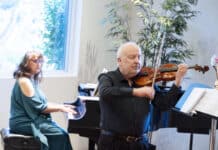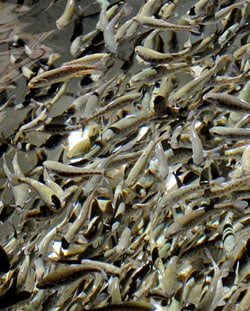When I heard about the Native Fish Camera Award the Bubbling Ponds Fish Hatchery in Page Springs received, there was no hesitation in deciding to grab the paper’s photojournalist, Michele Bradley Pacheco, jump in the car and take the 20-minute car ride to check it out.
Excited as we were, finding the Bubbling Ponds Fish Hatchery research center, which is different from the Page Springs Fish Hatchery, was a bit difficult, but we recovered quickly and took the long dirt road to the destination.
Finding Bubbling Ponds Fish Hatchery Manager David Ward was no problem at all once we got there. He was leaning over a pool of fish, changing their environment ever so slightly as to not disturb them.
The Bubbling Ponds Fish Hatchery, which is run by the Arizona Game and Fish Department, was recently honored with an Earth Cam’s Top 10 Cam Award.
The underwater eye sits in a pool that simulates a running river and is carefully hidden and focused under a big rock where several native fish swim throughout the day.
“It’s tricky to get the set up just right. The native fish in this particular pool like to hide, so I make them a big hiding place under a rock, then place the camera exactly where they’ll be for most of the time,” Ward said while pulling the streaming camera out of the water for us.
The Native Fish Camera is routinely moved so at any time one might see Colorado pikeminnow that can reach up to 100 pounds, roundtail chub which are found in Fossil Creek, razorback sucker, bonytail chub and many other native fish species, most of which are endangered.
The Bubbling Ponds Fish Hatchery research center is home to thousands of native and rare fish, most of which are taken care of every day by Ward.
Native fish at the hatchery include Gila chub, humpback chub, roundtail chub, bonytail chub, razorback sucker, Colorado pikeminnow, bluehead sucker, flannelmouth sucker, Sonora sucker, desert sucker, spikedace, loach minnow, longfin dace, speckled dace and Gila topminnow.
Some of these native fish are what Ward calls “not in great shape” because of their small numbers, which is why the Bubbling Ponds Fish Hatchery exists.
“Our job here is conservation of endangered species. We set up several experiments in effort to help propagate the fish just enough so that we can eventually reintroduce them into their native waters,” Ward said.
There are several reasons these fish are beginning to disappear from Arizona’s rivers, one of which Ward says is forest fires. The ash from the fires soaks their natural habitat, killing off many fish within a matter of days.
Like an old “Reading Rainbow” television show, Ward walked us through some of the endangered species plots in the treatment control center, which replicates a stream.
Ward uses hormones to feed certain fish, such as the pikeminnow, causing them to reproduce and lay eggs. From there, Ward takes the eggs and places them in another tank completely out of harms way to help propagate the species.
In some of the stream tanks outside, Ward discussed the flooding process. The tanks simulate a flood causing the bottom of the tank to be stirred up and all gravel cleaned away. The fish are genetically programed to lay their eggs at this time and do so quite rapidly.
“We put probably 10 or 15 fish in a few of these tanks and now there are close to 10,000,” Ward said.
The entire process took two months … talk about population control.
Of course, there are other species that have been introduced into Arizona’s natural habitat, which is another reason why some of the native fish are having problems.
Those species include flathead catfish, yellow bullhead, channel catfish, largemouth bass, smallmouth bass, green sunfish, red shiner, fathead minnow, mosquitofish, carp and, of course, crayfish.
Ward also discussed the Safe Harbor Agreement conservation project, which is propagating the fish to a certain point, then letting people take them home to their own private ponds to help grow them even more. From there, the fish are released into their natural habitat.
“Lots of people like to have fish around in their tanks, or ponds, so we open it up to them to take the fish home and help us repopulate the ones in need of assistance,” Ward said.
The Bubbling Ponds Fish Hatchery also has 13 large ponds to go along with the circular fiberglass tanks. The ponds are used for rearing the large fish native to the Colorado River.
Downstream from the Bubbling Ponds Fish Hatchery research center is the Page Springs Fish Hatchery, which, of course, is a tourist attraction and also grows rainbow trout for many excited anglers.
The Page Springs Fish Hatchery has a show pond that holds several rainbow trout, many over a foot in length and that look like they weigh close to 15 pounds.
A quarter machine nearby holds feed for the fish, giving trout watchers a closer look at the beautiful species.
Ward brought up a tale, which made both our photographer and I laugh, sharing with us that sometimes these rainbow trout from this show pond escape, making every angler in the area excited as can be to fish them out.
Of course, the otter population in the area has their fun, too, honing their skills at hunting as they feed off the trout.
“They are actually quite good at it. So much so that when we start to have a problem, we set traps and remove them from the area, then release them,” Ward said.
Further up the path, hundreds of thousands of trout swim in their man-made rivers under a big bunker that looks like it could hold an airplane. The Page Spring Fish Hatchery is the largest trout farm in Arizona.
Once the rainbow trout have grown to an acceptable size, the hatchery truck comes in and sucks out all the fish. It takes special equipment to ensure the trout arrive alive and healthy, a process the trout farm has down pat. Once the fish are loaded into the truck, they can be re-located anywhere in the state.
Back at the research center, Ward makes sure all fish are fed and even takes time to pull a Gila chub out of one of the tanks so we can take a few pictures and a closer look.
As I walked out the door to get back in the car, I realized this was my first trip to any type of fish hatchery, much less the one here in Page Springs, and with the day’s excitement, I hope it’s not the last.
Brian Bergner Jr. can be reached at 282-7795, Ext. 131, or e-mail bbergner@larsonnewspapers.com






















